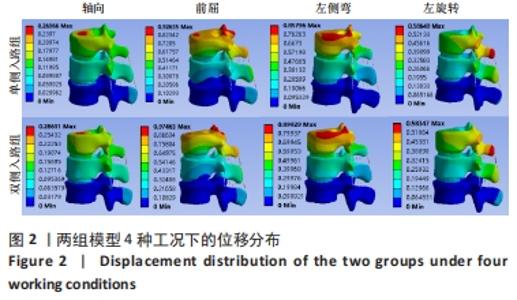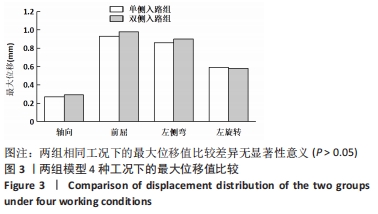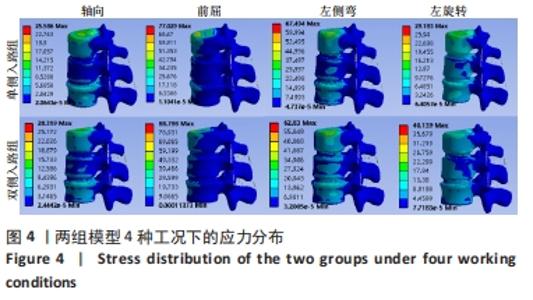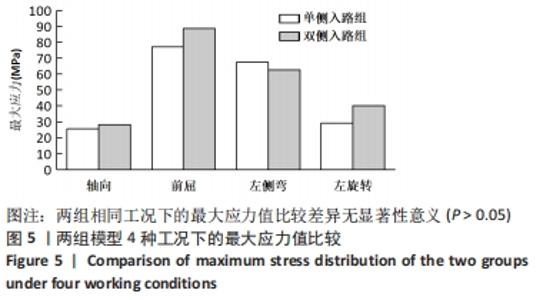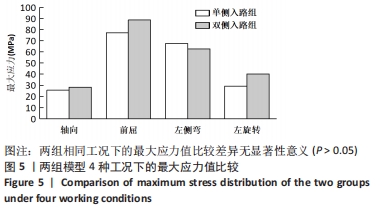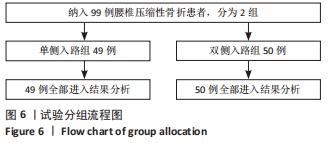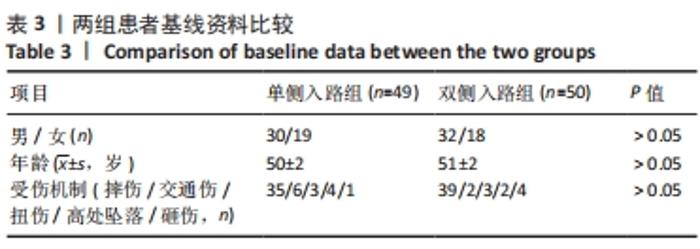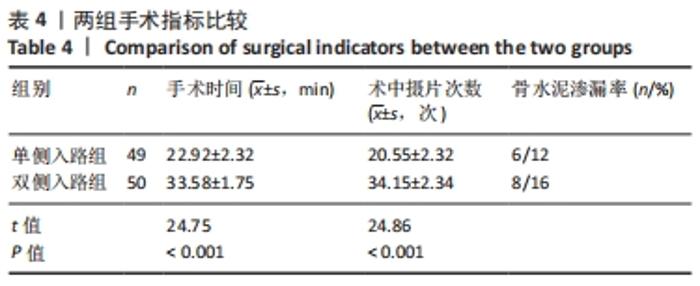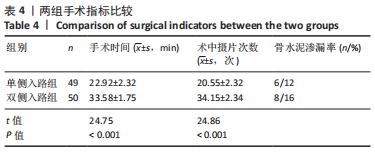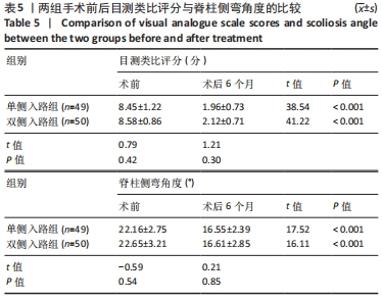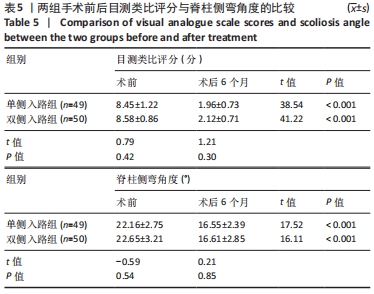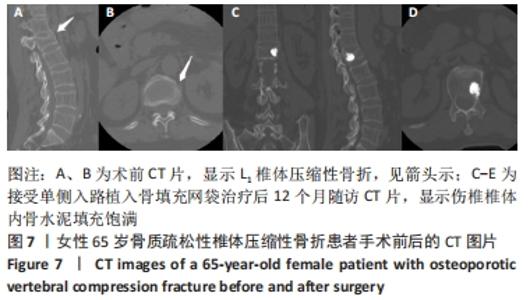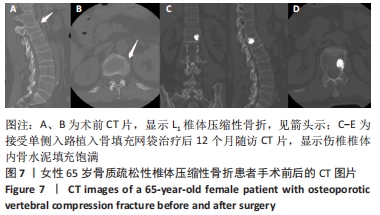Chinese Journal of Tissue Engineering Research ›› 2023, Vol. 27 ›› Issue (3): 391-397.doi: 10.12307/2023.016
Previous Articles Next Articles
Finite element analysis and application of unilateral and bilateral bone-filling mesh container in treatment of osteoporotic vertebral compression fracture
Lu Hui1, 2, Wu Qimei3, Liu Rong2, 4
- 1School of Medicine, Wuhan University of Science and Technology, Wuhan 430081, Hubei Province, China; 2Institute of Medical Innovation and Transformation, 4Department of Orthopedics, Puren Hospital of Wuhan University of Science and Technology, Wuhan 430080, Hubei Province, China; 3Wuhan Liu Sanwu Traditional Chinese Medicine Bone Injury Hospital, Wuhan 431400, Hubei Province, China
-
Received:2021-09-24Accepted:2021-12-01Online:2023-01-28Published:2022-05-19 -
Contact:Liu Rong, PhD, Associate professor, Associate chief physician, Master’s supervisor, Institute of Medical Innovation and Transformation, and Department of Orthopedics, Puren Hospital of Wuhan University of Science and Technology, Wuhan 430080, Hubei Province, China Wu Qimei, Associate chief physician, Wuhan Liu Sanwu Traditional Chinese Medicine Bone Injury Hospital, Wuhan 431400, Hubei Province, China -
About author:Lu Hui, Master candidate, School of Medicine, Wuhan University of Science and Technology, Wuhan 430081, Hubei Province, China; Institute of Medical Innovation and Transformation, Puren Hospital of Wuhan University of Science and Technology, Wuhan 430080, Hubei Province, China -
Supported by:General Project of Hubei Natural Science Foundation Committee, No. 2020CFB548 (to LR)
CLC Number:
Cite this article
Lu Hui, Wu Qimei, Liu Rong. Finite element analysis and application of unilateral and bilateral bone-filling mesh container in treatment of osteoporotic vertebral compression fracture[J]. Chinese Journal of Tissue Engineering Research, 2023, 27(3): 391-397.
share this article
| [1] SVEJME O, AHLBORG HG, NILSSON JÅ, et al. Early menopause and risk of osteoporosis, fracture and mortality: a 34-year prospective observational study in 390 women. BJOG. 2012;119:810-816. [2] NAKASHIMA D, KANCHIKU T, NISHIDA N, et al. Finite element analysis of compression fractures at the thoracolumbar junction using models constructed from medical images. Exp Ther Med. 2018;15: 3225-3230. [3] 金成浩,蔡迎,钟杰林,等.单侧与双侧经皮后凸成形治疗骨质疏松性胸腰椎骨折[J].中国矫形外科杂志,2020,28(18):1712-1715. [4] LIEBERMAN IH, DUDENEY S, REINHARDT MK, et al. Initial outcome and efficacy of “kyphoplasty” in the treatment of painful osteoporotic vertebral compression fractures. Spine (Phila Pa 1976). 2001;26:1631-1638. [5] 吴宏梓,汪少波,拉华欠,等.骨填充网袋术治疗骨质疏松性椎体压缩骨折疗效与安全性的Meta分析[J].中华创伤杂志,2020, 36(5):433-441. [6] ZHENG Z, LUK KEITH DK, KUANG G, et al. Vertebral augmentation with a novel Vessel-X bone void filling container system and bioactive bone cement. Spine (Phila Pa 1976). 2007;32:2076-2082. [7] STEINMANN J, TINGEY CT, CRUZ G, et al. Biomechanical comparison of unipedicular versus bipedicular kyphoplasty. Spine (Phila Pa 1976). 2005;30:201-205. [8] PAPADOPOULOS EC, EDOBOR-OSULA F, GARDNER MJ, et al. Unipedicular balloon kyphoplasty for the treatment of osteoporotic vertebral compression fractures: early results. J Spinal Disord Tech. 2008;21:589-596. [9] LU H, PENG H, PENG Z, et al. The Application of Digital Design Combined with 3D Printing Technology in Skin Flap Transplantation for Fingertip Defects during the COVID-19 Epidemic.Biomed Res Int. 2021;2021:5554500. [10] ROHLMANN A, BOUSTANI HN, BERGMANN G, et al. A probabilistic finite element analysis of the stresses in the augmented vertebral body after vertebroplasty. Eur Spine J. 2010;19:1585-1595. [11] BAROUD G, NEMES J, HEINI P, et al. Load shift of the intervertebral disc after a vertebroplasty: a finite-element study. Eur Spine J. 2003;12: 421-426. [12] GOEL VK, KONG W, HAN JS, et al. A combined finite element and optimization investigation of lumbar spine mechanics with and without muscles. Spine (Phila Pa 1976). 1993;18:153115-153141. [13] NOAILLY J, LACROIX D, PLANELL JA. Finite element study of a novel intervertebral disc substitute. Spine (Phila Pa 1976). 2005;30:2257-2264. [14] ZHANG L, YANG G, WU L, et al. The biomechanical effects of osteoporosis vertebral augmentation with cancellous bone granules or bone cement on treated and adjacent non-treated vertebral bodies: a finite element evaluation. Clin Biomech (Bristol, Avon). 2010;25:166-172. [15] LIANG D, YE L, JIANG X, et al. Biomechanical effects of cement distribution in the fractured area on osteoporotic vertebral compression fractures: a three-dimensional finite element analysis. J Surg Res. 2015;195:246-256. [16] CHUNG SK, KIM YE, WANG K. Biomechanical effect of constraint in lumbar total disc replacement: a study with finite element analysis. Spine (Phila Pa 1976). 2009;34:1281-1286. [17] DENIS F. The three column spine and its significance in the classification of acute thoracolumbar spinal injuries. Spine (Phila Pa 1976). 1983;8: 817-831. [18] ROHLMANN A, ZANDER T, RAO M, et al. Applying a follower load delivers realistic results for simulating standing.J Biomech. 2009;42: 1520-1526. [19] 赵文韬,秦大平,张晓刚,等.骨质疏松性椎体压缩骨折椎体强化术后不同椎体高度对相邻椎体应力影响的有限元分析[J].中国骨质疏松杂志,2018,24(9):1141-1147. [20] 秦大平,张晓刚,权祯,等.骨质疏松症患者脊柱胸腰段椎体力学稳定性变化与椎体压缩性骨折风险预测的有限元分析[J].中国医学物理学杂志,2021,38(4):485-494. [21] CHIU JC, STECHISON MT. Percutaneous vertebral augmentation and reconstruction with an intravertebral mesh and morcelized bone graft. Surg Technol Int. 2005;14:287-296. [22] GARFIN SR, YUAN HA, REILEY MA. New technologies in spine: kyphoplasty and vertebroplasty for the treatment of painful osteoporotic compression fractures. Spine (Phila Pa 1976). 2001;26: 1511-1515. [23] FRIBOURG D, TANG C, SRA P, et al. Incidence of subsequent vertebral fracture after kyphoplasty. Spine (Phila Pa 1976). 2004;29: 2270-2276; discussion 2277. [24] 赵文韬,秦大平,张晓刚,等.功能复位椎体强化治疗骨质疏松性椎体压缩骨折的有限元分析[J].世界科学技术-中医药现代化, 2018,20(3):439-445. [25] 王健,李凯,陈博,等.胸腰椎体压缩性骨折三维有限元模型的建立和分析[J].中国矫形外科杂志,2016,24(16):1498-1503. [26] 叶林强.辨稳论治在经皮椎体强化术治疗骨质疏松性椎体压缩骨折的意义[D].广州:广州中医药大学,2016. [27] PANJABI MM, KIFUNE M, LIU W, et al. Graded thoracolumbar spinal injuries: development of multidirectional instability. Eur Spine J. 1998; 7(4):332-339. [28] SVENSSON HK, OLSSON LE, HANSSON T, et al. The effects of person-centered or other supportive interventions in older women with osteoporotic vertebral compression fractures-a systematic review of the literature. Osteoporos Int. 2017;28:2521-2540. [29] ZHANG H, XU C, ZHANG T, et al. Does Percutaneous Vertebroplasty or Balloon Kyphoplasty for Osteoporotic Vertebral Compression Fractures Increase the Incidence of New Vertebral Fractures? A Meta-Analysis. Pain Physician. 2017;20:E13-E28. [30] STEVENSON M, GOMERSALL T, LLOYD JM, et al. Percutaneous vertebroplasty and percutaneous balloon kyphoplasty for the treatment of osteoporotic vertebral fractures: a systematic review and cost-effectiveness analysis. Health Technol Assess. 2014;18:1-290. [31] TSOUMAKIDOU G, TOO CW, KOCH G, et al. CIRSE Guidelines on Percutaneous Vertebral Augmentation. Cardiovasc Intervent Radiol. 2017;40:331-342. [32] GENANT HK, WU CY, VAN KC, et al. Vertebral fracture assessment using a semiquantitative technique. J Bone Miner Res. 1993;8:1137-1148. [33] HSU C, CHAO C, WANG J, et al. Increase of pullout strength of spinal pedicle screws with conical core: biomechanical tests and finite element analyses. J Orthop Res. 2005;23:788-794. [34] KILINÇER C,INCEOGLU S, SOHN MJ, et al. Effects of angle and laminectomy on triangulated pedicle screws. J Clin Neurosci. 2007;14: 1186-1191. [35] HASHEMI A, BEDNAR D, ZIADA S. Pullout strength of pedicle screws augmented with particulate calcium phosphate: an experimental study. Spine J. 2009;9:404-410. [36] SAIRYO K, GOEL VK, MASUDA A, et al. Three-dimensional finite element analysis of the pediatric lumbar spine. Part I: pathomechanism of apophyseal bony ring fracture. Eur Spine J. 2006;15:923-929. [37] SAIRYO K, GOEL VK, MASUDA A, et al. Three dimensional finite element analysis of the pediatric lumbar spine. Part II: biomechanical change as the initiating factor for pediatric isthmic spondylolisthesis at the growth plate. Eur Spine J. 2006;15:930-935. [38] 刘祥飞,何金国,蒋钰钢,等.单侧与双侧入路椎体成形术治疗老年骨质疏松性椎体压缩骨折的有限元分析及临床应用[J].医用生物力学,2018,33(3):218-223. |
| [1] | Li Zhifei, Yang Yin, Chen Hualong, Liang Qinqiu, Zhong Yuanming, Zhang Yisheng. Finite element analysis of the correlation between tilt angle of titanium cage and postoperative subsidence of titanium cage after anterior subtotal cervical corpectomy, decompression and fusion [J]. Chinese Journal of Tissue Engineering Research, 2024, 28(9): 1313-1319. |
| [2] | Chen Mengmeng, Bao Li, Chen Hao, Jia Pu, Feng Fei, Shi Guan, Tang Hai. Biomechanical characteristics of a novel interspinous distraction fusion device BacFuse for the repair of lumbar degenerative disease [J]. Chinese Journal of Tissue Engineering Research, 2024, 28(9): 1325-1329. |
| [3] | Liang Cheng, Zhang Linqi, Wang Guan, Li Wen, Duan Ke, Li Zhong, Lu Xiaobo, Zhuo Naiqiang. Finite element and biomechanical analysis of different implants in repair for unilateral unstable pelvic posterior ring injury [J]. Chinese Journal of Tissue Engineering Research, 2024, 28(9): 1336-1341. |
| [4] | Yang Junliang, Lu Tan, Xu Biao, Jiang Yaqiong, Wang Fucheng. Three-dimensional finite element analysis of effects of partial anterior cruciate ligament rupture on knee joint stress [J]. Chinese Journal of Tissue Engineering Research, 2024, 28(9): 1347-1353. |
| [5] | Yang Cekai, Cai Zhuoyan, Chen Ming, Liu Hao, Weng Rui, Cui Jianchao, Zhang Shuncong, Yao Zhensong. Relationship between degeneration of paraspinal muscle and refractures in postmenopausal women treated by percutaneous vertebroplasty [J]. Chinese Journal of Tissue Engineering Research, 2024, 28(9): 1414-1419. |
| [6] | Weng Rui, Lin Dongxin, Guo Haiwei, Zhang Wensheng, Song Yuke, Lin Hongheng, Li Wenchao, Ye Linqiang. Abnormal types of intervertebral disc structure and related mechanical loading with biomechanical factors [J]. Chinese Journal of Tissue Engineering Research, 2024, 28(9): 1436-1442. |
| [7] | Xiaheida·Yilaerjiang, Nijiati·Tuerxun, Reyila·Kuerban, Baibujiafu·Yelisi, Chen Xin. Three-dimensional finite element analysis of the distribution pattern of stress in bone tissues with different characteristics [J]. Chinese Journal of Tissue Engineering Research, 2024, 28(8): 1277-1282. |
| [8] | Tong Yibo, Li Minghui. Influencing factors of adjacent vertebral re-fracture in patients with osteoporotic vertebral fractures after percutaneous vertebroplasty [J]. Chinese Journal of Tissue Engineering Research, 2024, 28(8): 1241-1246. |
| [9] | Wang Qiang, Li Shiyun, Xiong Ying, Li Tiantian. Biomechanical changes of the cervical spine in internal fixation with different anterior cervical interbody fusion systems [J]. Chinese Journal of Tissue Engineering Research, 2024, 28(6): 821-826. |
| [10] | Wei Yuanbiao, Lin Zhan, Chen Yanmei, Yang Tenghui, Zhao Xiao, Chen Yangsheng, Zhou Yanhui, Yang Minchao, Huang Feiqi. Finite element analysis of effects of sagittal cervical manipulation on intervertebral disc and facet joints [J]. Chinese Journal of Tissue Engineering Research, 2024, 28(6): 827-832. |
| [11] | Zhang Rui, Wang Kun, Shen Zicong, Mao Lu, Wu Xiaotao. Effects of endoscopic foraminoplasty and laminoplasty on biomechanical properties of intervertebral disc and isthmus [J]. Chinese Journal of Tissue Engineering Research, 2024, 28(6): 833-839. |
| [12] | Kang Zhijie, Cao Zhenhua, Xu Yangyang, Zhang Yunfeng, Jin Feng, Su Baoke, Wang Lidong, Tong Ling, Liu Qinghua, Fang Yuan, Sha Lirong, Liang Liang, Li Mengmeng, Du Yifei, Lin Lin, Wang Haiyan, Li Xiaohe, Li Zhijun. Finite element model establishment and stress analysis of lumbar-sacral intervertebral disc in ankylosing spondylitis [J]. Chinese Journal of Tissue Engineering Research, 2024, 28(6): 840-846. |
| [13] | Zhang Min, Peng Jing, Zhang Qiang, Chen Dewang. Mechanical properties of L3/4 laminar decompression and intervertebral fusion in elderly osteoporosis patients analyzed by finite element method [J]. Chinese Journal of Tissue Engineering Research, 2024, 28(6): 847-851. |
| [14] | Xue Xiaofeng, Wei Yongkang, Qiao Xiaohong, Du Yuyong, Niu Jianjun, Ren Lixin, Yang Huifeng, Zhang Zhimin, Guo Yuan, Chen Weiyi. Finite element analysis of osteoporosis in proximal femur after cannulated screw fixation for femoral neck fracture [J]. Chinese Journal of Tissue Engineering Research, 2024, 28(6): 862-867. |
| [15] | Huang Peizhen, Dong Hang, Cai Qunbin, Lin Ziling, Huang Feng. Finite element analysis of anterograde and retrograde intramedullary nail for different areas of femoral shaft fractures [J]. Chinese Journal of Tissue Engineering Research, 2024, 28(6): 868-872. |
| Viewed | ||||||||||||||||||||||||||||||||||||||||||||||||||
|
Full text 382
|
|
|||||||||||||||||||||||||||||||||||||||||||||||||
|
Abstract 623
|
|
|||||||||||||||||||||||||||||||||||||||||||||||||
